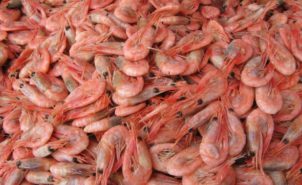
By Brototi Roy. Global trade of the luxury commodity that shrimp is ignores the true human and environmental impact.
Watching villagers standing waist deep in the brackish water of the Sundarbans – also home to crocodiles, Bengal tigers and poisonous snakes – armed with just hand nets is terrifying. Dayapur is an island village located in the South 24 Parganas district of West Bengal, India. Residents catch shrimp seeds from the riverbeds, which they sell for starvation wages to nearby shrimp farm owners. From there, slave labour turns them into the cheap frozen shrimp which many people eat during the festive season.
‘Shrimp farming is making more money for the rich, who invest in the big shrimp ponds and processing industries,’ says Jagdish Chandra Mridha who has grown up catching shrimp seeds and works on the boats. ‘Poor people like us can’t even afford a boat and have to stand in water for hours. We are paid ten times less than what we were even five to six years ago.’ Mridha adds that this job is usually carried out by children, women and old people.
In the Sundarbans, the extremely disproportionate risks and returns of the shrimp industry became visible through the muddiest of all waters. Most shrimp from coastal countries in the Global South comes at prices which do not account for the hidden socio-ecological costs, ranging from destroying fragile ecosystems to promoting slave labor.
Value for whom?
The story of shrimp is a relatively recent one. Commercial shrimp aquaculture, primarily for exports, has been promoted across the Global South since the mid-1970s by governments and international institutions such as the World Bank and International Monetary Fund. According to the UN’s Food and Agriculture Organization, shrimp now has the second highest value in seafood trade , after salmon, and its production is projected to continue growing in the next decade.
In 2015, the US and the European Union were the two largest importers of shrimp. The lucrative profits in the form of foreign exchange are concentrated in the hands of a few, who are ruthless in cutting costs and creating legal loopholes. An investigative study by the Environmental Justice Foundation revealed how the rural poor and the environment bear the real brunt of commercial shrimp aquaculture.
In countries like India and Bangladesh, agricultural lands are converted into shrimp ponds, often forcibly. This renders them forever unfit for cropping, due to the high salinity. As the locals don’t eat shrimp, space for food production in the Global South is sacrificed for food production for the Global North. In most other cases, the mangrove forests upon which the poor also depend for their survival are destroyed to build shrimp ponds.
More than shrimp
Shrimp is just one part of the broader conflict between global free trade and environmental protection. This trend of neglecting the true value of commodities is known as Ecologically Unequal Exchange (EUE). To explain it simply this is the act of exporting goods from poorer countries to rich nations at prices which do not take into account local externalities such as ecosystem costs, depletion of natural resources or violation of human rights generated by these exports. As new insights show, EUE is an underlying source of most ecological distribution conflicts today.
Numerous cases of ecological distribution conflicts, stemming from resource exploitation in the Global South for the purpose of trade, such as disposal of e-waste, fossil fuel extraction and mining are mapped in the Environmental Justice Atlas.
Inequalities and injustices give rise to environmental justice movements by local people protecting their land and livelihoods. In Santa Rita, Brazil, a large shrimp company called PRJC has been severely harming the mangrove forests through its production practices. In 2007, the company broke a dike contaminating mangroves killing several species of marine animals. In 2011 it dumped 14 tons of virus infested shrimps into mangroves putting the entire ecosystem at risk. The fishermen and the local communities took collective action, launching campaigns and legal action. However, PRJC is still operational.
In South East Asian countries, especially Thailand, the situation is even grimmer. In 2014, after a six-month long investigation, the Guardian reported how slavery is connected to leading producers and traders of shrimp, including the top four global retailers: Walmart, Carrefour, Costco and Tesco. This was followed by another report in 2015 about the trafficking of Rohingya migrants who were sold as slave labour for the export-oriented seafood industry in Thailand, with shrimp as the most highly valued commodity. These enslaved workers are locked up under horrific conditions, including regular beatings, 20 hour shifts and execution style killing.
So, before reaching for frozen shrimp in your nearest supermarket, do give a thought to its journey from the coastal South and what it entails.
This article was first published at The New Internationalist: https://newint.org/blog/2017/01/30/shrimp-ecologically-unequal-exchange/

The project ENVJUSTICE has received funding from the European Research Council (ERC) under the European Union’s Horizon 2020 research and innovation programme (grant agreement No. 695446)